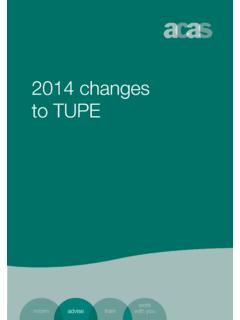Transcription of urges almon Guide to group reorganisations and corporate ...
1 corporate Burges Salmon Guide to group reorganisations and corporate simplifications Contents Introduction 3. Why carry out a reorganisation? 4. What's involved? 5. What should you watch out for? 7. Other key issues 7. Key contacts 11. 2. Introduction This Guide provides an overview of group reorganisations and corporate simplifications. It covers the reasons why reorganisations are carried out, the process involved and some of the key issues which need to be considered in the context of a reorganisation. A reorganisation usually involves the transfer of assets, which may be shares in another group company or the business of another group company, from one group company to another. 3. Why carry out a reorganisation?
2 There are a number of reasons as to why a reorganisation may be implemented. Common reasons for group reorganisations are: To simplify the corporate structure of the group : a period of significant acquisitions or the use of special purpose vehicles can result in a group structure which is too complex for current requirements. Alternatively, it may be that elements of a group 's businesses are carried out by a number of companies, and the group wants to rationalise its structure so that the elements of each trade sit in one company. A group may also consist of companies in a number of countries and an overseas parent may wish to simplify its UK structure. A complex group structure can: bring significant additional costs to the business.
3 Absorb significant amounts of management time; and have an impact on how a group is viewed by HMRC. The benefits of simplifying a large structure include: fewer companies to manage and more time to focus on business issues;. reduced complexity in the group structure could improve the group 's risk rating with HMRC;. lower compliance costs; and simplified reporting structure. A pre-step for a sale of the group or part of the group : the objective may be to simplify the corporate structure ( remove dormant companies from the group ) to make it more attractive to a buyer, or commonly a reorganisation may be appropriate where the group (or a company) only wishes to sell part of its business. For example, if a company carries on a number of trades and only some are to be sold, then as a pre-step those trades could be packaged into a stand-alone subsidiary which is then sold to the buyer.
4 After an acquisition: following an acquisition it may be necessary for the acquiring group to move the purchased assets around its group to ensure they are in the most appropriate subsidiary. For example, this may involve the transfer (commonly known as a hive-up or hive down) of businesses to other group companies, or the target group or company being transferred to a holding company in the group if it was not the acquirer. 4. In preparation for an acquisition: the acquiring group may want to restructure in advance of an acquisition so that the target group /business can easily fit into the acquiring group 's structure. What's involved? Typically a corporate simplification project is split into the following stages: 1.
5 Planning: Planning, discussion with stakeholders and appointing advisers (typically legal and tax). 2. Due diligence (accounting, legal and tax): The focus here is on assessing whether there are any company specific issues which could have an impact on the proposed simplification project. Examples include: the availability of distributable reserves;. the terms of any regulatory approvals, licences or permissions; and third party consent requirements. The due diligence process also identifies the assets which need to be transferred from any companies which have been selected for strike-off. 3. Steps plan: An overall plan for the simplification project is developed which sets out the key objectives and primarily considers the tax implications of the proposed steps.
6 The plan will commonly split out each of the group companies which are to be part of the project, and this may range from simple dormant companies which can be eliminated without further additional work to key trading companies which must be retained. A. more detailed plan is then produced for the project and this contains detailed steps for each company to take before it is eliminated. It also sets out the relevant legal documents which need to be prepared and executed for each step. 4. Approvals: Once a detailed plan has been developed and before any steps are taken to simplify the group , all relevant approvals/consents/clearances should be obtained. Bank and shareholder consent may be required.
7 5. Business/asset transfers: Business/asset transfer agreements will be used to transfer businesses/assets from those companies which are being eliminated to the companies which are being retained in the group structure. 5. Price: These transfers normally take place at book value using the carrying value shown in the company's accounts (assuming that the company transferring the assets has distributable reserves). In other circumstances the transfer must take place at market value. Advice should be taken as to what value is used for each transfer. Tax: The tax treatment of any business/asset transfer should also be considered. If both companies are in the same group for tax purposes, then it is likely that the transfers can be undertaken on a tax neutral basis.
8 However, particular attention needs to be paid to the consequences, later on, of such tax neutral treatment ( there might be a claw back of the tax saved if the relevant companies are de-grouped at some time in the future). Particular attention needs to be paid to VAT, the taxable status of the assets, VAT. group arrangements, and the possibility of going concern treatment should be addressed. balance sheets: Commonly in relation to those companies which are targeted for strike off, steps are carried out beforehand to simplify their balance sheets. Typically this will involve capital reductions (where the companies have significant issued share capital/share premium), the declaration of dividends and/or steps to deal with intra- group balances.
9 Companies: For companies with a straightforward history or no trading history, strike off is probably the most cost-effective route. Liquidation using the members' voluntary liquidation procedure may be more appropriate for companies with a complex trading history. Although a company can be struck off the register of companies, there are circumstances when it can be restored. Under the Companies Act 2006, an application can be made to the court for restoration of a company to the register for a period of six years from the date of the dissolution of the company (there is no time limit if the application relates to a personal injury claim). 6. What should you watch out for? If you are planning a corporate simplification project then particular attention should be given to: tax and ensuring that none of the steps involved in the corporate simplification project trigger a tax liability (including stamp duty and stamp duty land tax) or result in the loss of tax reliefs.
10 Pensions if there is a defined benefit scheme within the group and participating employers (or the broader employer covenant ) may be affected; and ensuring that companies involved in the project have sufficient distributable reserves and are solvent. In addition, directors should consider their duties to the company and corporate benefit issues at all stages of the project. Other key issues to consider as part of the project include: Availability of distributable reserves: As part of stage 5 (business/asset transfers) it may be necessary to create distributable reserves in the company which is transferring assets. The availability of distributable reserves then means that the transfer can take place at book value.








